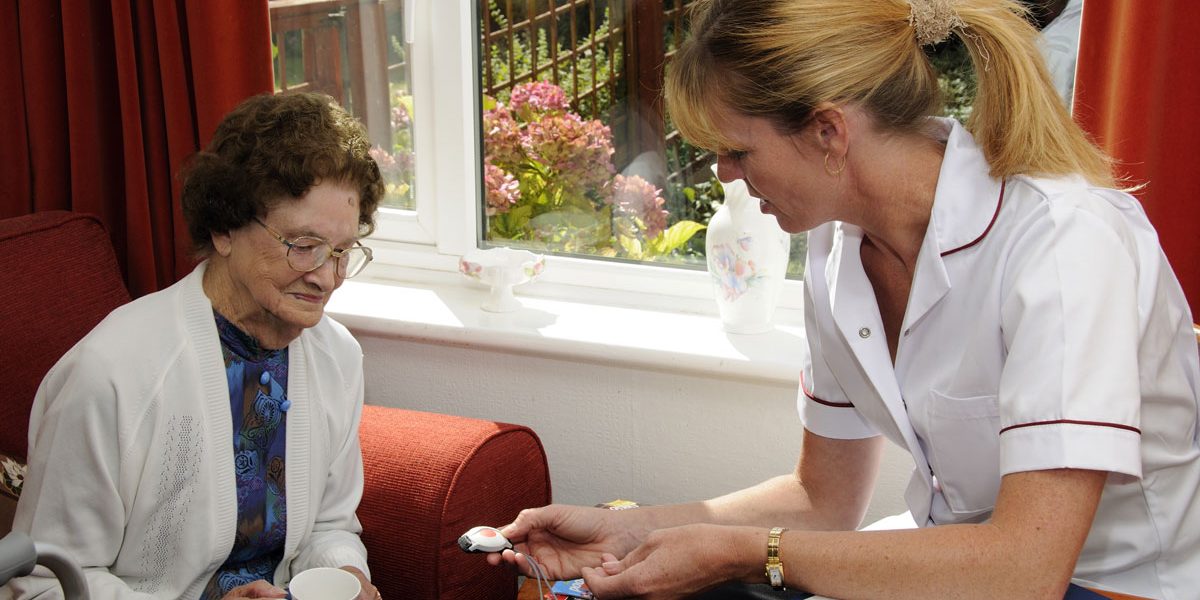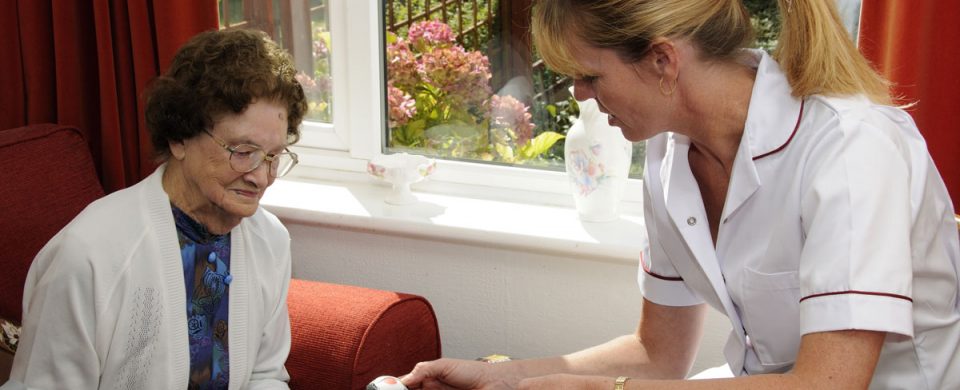
Personal Emergency Response Systems for At-Risk Individuals and with Disabilities

Do you have a loved one who is an at-risk individual or one with disabilities?
Emergencies can happen to anyone. If a medical emergency occurs concerning a person with a disability, it can be even more difficult.
At-risk individuals, according to the American Journal of Managed Care, are populations with psychological, social, or physical health needs such as the chronically ill, disabled, and those with mental conditions.
Persons such as these need a support network to assist them in an emergency, including medical ones. Family members or caregivers can’t be available 24/7; hence, a monitored personal security system can greatly help.
A Personal Emergency Response System can be an effective tool for such individuals to help them in an emergency where immediate assistance is critical. This system has a wearable panic button that can be pressed to receive emergency assistance. The user does not have to call 911 and can immediately speak to an operator to ask for help.
Find out more about Personal Emergency Response Systems (PERs) and compare prices to find the right one for your needs. Just fill out the short online form on this page, free of charge!
Why buy a Personal Emergency Response System (PERs) for emergencies?

According to Statistics Canada, there are some 3.8 million Canadians with limited daily activities because of an existing disability. The majority of these individuals have mobility issues, flexibility limitations, and chronic pain.
Studies show that aging technologies such as personal emergency response systems can enhance the quality of life, health, and quality of care received by elderly people.
Further, these technologies also benefit persons with disabilities. To a person with a disability, a simple task like calling on the phone in an emergency can be a time-consuming, if not a difficult task.
A Personal Emergency Response System (PERs) is a wearable device (bracelet or pendant) that gives immediate access to emergency support with just one push of a button.
The system has the following important features:
- Emergency panic button
- 2-way voice communication system
- Waterproof or water-resistant
- Light-weight and portable
- Attractive design
- Auto fall detection (optional)
- GPS tracking (optional)
There are instances when you may not have a smartphone on hand or you can’t use it because you are in pain, can’t speak, or unable to do so.
If you have a panic button on your person, all you need to do is to press the emergency button to speak to an operator who is well-trained in emergency management. Monitoring centers are also staffed with multi-lingual operators to make sure you can communicate in your preferred language.
Yes, it is so easy and convenient to get HELP anytime you need it. This service is available 24/7 because monitoring centers operate without interruption.
How does a Personal Emergency Response System Work?
Personal Emergency Response Systems (PERS) are also called medical alert systems or emergency panic buttons. They allow you to get HELP in any emergency by pushing the panic button.
This type of device has 3 important components, namely:
- A Transmitter (usually worn on the wrist or around the neck)
- A base console connected to a landline
- Emergency response centers to take and monitor calls
The transmitter, in the form of a pendant, watch, or clipped to a belt, is lightweight and easy to wear. Whenever you need help, you can press the button to send an alert to the monitoring center.
The monitoring center will speak to the user through the 2-way communication system in the panic button to verify the emergency. It will then dispatch the emergency services required or notify persons on the user’s contact list.
It is possible to buy a Personal Emergency Response System or lease it, depending on the chosen provider.
While most private insurers and public health insurance do not cover the cost of this device, you can choose a monthly plan that suits you needs and budget.
Compare FREE and NO-OBLIGATION quotes using our short online form today!
Types of Personal Emergency Response Systems to Consider
When shopping for a Personal Emergency Response System, you will find several choices in the market to consider.
To make it easy and save you time, we present below the types of PERS you can compare and choose for your needs.
Home-based and Mobile Personal Emergency Response Systems
Home-based personal emergency response systems are ideal for individuals who almost never go out. This makes it ideal for seniors who are recovering from an illness, surgery, or have mobility and other issues.
Usually connected to a landline, a home personal emergency response system has varying ranges (200, 300, 600, or 1000 ft.) from the base console. Thus, make sure to choose the right type of system based on the size of your home. This will ensure your protection works no matter where you are inside your home.
In-home personal emergency response systems have standard features which include the portable panic button and 2-way voice communication.
The user is required to push the panic button to summon help. These standard systems are the most inexpensive monitored systems in the market.
Mobile systems, on the other hand, don’t require a landline. They are connected to cellular networks which makes them ideal for active seniors and adults. They can be worn anywhere to ensure access to emergency assistance whenever and wherever you are.
Wireless systems also have extra features such as fall detection and GPS tracking, adding layers of protection to your Personal Emergency Response System.
While mobile systems cost more than standard systems, they are more convenient because they have a wider range and can protect you on the go.
Monitored or Non-Monitored System
Personal Emergency Response Systems are classified based on who receives the emergency alert.
Monitored systems are connected to a monitoring center with 24/7 operations. Trained personnel receive and monitor alerts and dispatch the police, fire, or medical responders, as needed.
They can also notify persons on the user’s contact list if the situation requires the presence or assistance of a family member.
The response of a monitoring center is measured in seconds (within 20 to 40 seconds), and not minutes, ensuring that the user receives help immediately. This is very important in a medical emergency where every second can mean life or death.
Monitoring centers must be compliant with the quality standards of the Central Station Alarm Association (CSAA) International. Many monitoring centers are given the CSAA Five Diamond Certification, the highest recognition for monitoring centers in terms of excellence.
If you don’t have a support network (friends or relatives that can immediately come to assist you in an emergency), it is advisable to have a monitored system. You will be paying monthly monitoring fees for this service but the cost is minimal compared to the convenience and peace of mind you get.
Non-monitored systems, on the other hand, dial pre-established numbers when the panic button is pressed. It can dial the numbers of family members or 911. The system keeps calling numbers saved in the system until someone answers. Some systems are designed to contact only 911.
Such systems rely heavily on the availability of contacts to react to an alert notification. As you may know, some people can be unavailable at times and won’t be able to act on an alert as quickly as a monitoring center. They could be asleep, running errands, or busy at work. Hence, the level of response is not as reliable as a professional monitoring center.
If you choose a non-monitored system, you will need to buy the equipment but there are no monthly monitoring fees and no long-term commitment.
Fall detectors
The Centers for Disease Control and Prevention reports that 1 out of 4 older adults suffers from a fall every year. Around 20% of such falls lead to serious injuries.
Some personal emergency response systems come with automatic fall detection. This technology allows a fall to be detected by the system automatically, based on established parameters that include speed, height, acceleration, etc. This means that if the user falls and is unable to press the panic button, an alert is triggered and sent to the monitoring center.
This additional layer of protection is not available in all systems. Compare multiple offers before you choose and find the right fall detection system for your needs.
Reasons why fall detection is essential

Millions of seniors 65 and older fall every year. A person with a history of falls is likely to fall again.
Falls are serious and very costly in terms of money and its consequences on one’s health. More than 800,000 patients are taken to a hospital because of a fall injury each year, and in most cases, it is a head injury or a fractured hip. It can also result in traumatic brain injuries.
In the United States, the total medical costs due to falls amounted to more than $50 billion in 2015 alone. Only 75% of this amount was shouldered by health insurance.
And while not all falls cause injuries, many of them do result in injuries that make it difficult for someone to get around or be independent. In fact, many falls precipitate long-term care.
It is not unheard of for a senior or person with a disability to wait hours, sometimes days, to receive medical assistance because they could not call for help. You may have heard people who suffered a stroke and collapsed lay waiting for a couple of days before they were found.
In a medical emergency, the patient must receive medical care at the soonest possible time to increase the chances of recovery.
Fall detection will be valuable in such cases and will make sure that HELP arrives after a fall, even if the user fails to press the panic button.
There are several medical alert companies offering fall detection systems that could match your needs and budget.
Take 2 minutes to fill out the form on this page to receive FREE AND NO COMMITMENT quotes. Compare them to save time and money and get the best fall detector in Canada for your safety.
Personal Emergency Response Systems: Overview of Costs
You will surely want to know the cost of personal emergency response systems. Below you will find the fees associated with these devices to find one that suits your budget.
When buying your PERS, you will have to pay the following fees, depending on your chosen provider:
- Equipment Fee
- Installation or Activation Fee
- Monitoring Fees
The equipment fee is a one-time payment for the system which includes the console, batteries, and the wearable panic button (bracelet, belt clip, or pendant.)
The cost of the equipment varies but the average price is $200 or under from among the different providers. A few companies don’t charge an outright fee for the equipment but include it in the monitoring contract. You will need to return the equipment when you end the service.
The installation or activation fee also varies among the different providers. The average cost for activation or installation is $99. Some companies don’t charge this fee.
Monitoring fees covers the monitoring service you receive for your panic button. The cost varies based on your type of system (landline or wireless) and the level of protection (standard, with fall detection, with GPS tracking, medication reminders, etc.)
For monitoring services, a few providers offer month-to-month service which you can cancel at any time. Other providers require a fixed commitment which could be from 6 months, 24, months, or 36 months.
When you buy your system, make sure to understand the fees correctly. Some companies require a contract for the monitoring service so make sure you are willing to be tied down for the period required. You can also check if the provider covers other cities as well in case you need to move away.
What is the best Personal Emergency Response System?
Are you looking for the best Personal Emergency Response System (PERS)? This is the best place to look.
Below you will find a comparison of the leading Personal Emergency Response Systems in Canada to compare.
Galaxy Medical Alert Systems
The company offers a variety of personal emergency response systems for care and comfort when medical assistance is needed.
It has a hands-free base station with 2-way voice communication that works with a wireless necklace or wrist transmitter. The alert is sent to its Galaxy Response Center with Emergency Medical Technicians on hand to assist.
Their offerings include:
Cellular system: $44.95 – $449.50
Fall Detection: $39.95 – $399.50
Home and on the go with GPS Tracking: $34.95 – $349.50
Home and Yard system: $34.95 – $349.50
Home System: $29.95: $299.50
Mobile + fall detection: $49.95 – $499.50
You can also buy a second pendant to cover an additional person, such as if you want protection for both your parents.
Philips Lifeline Medical Alert
This company is popular in the US and Canada. It also offers a personal emergency response service that allows you to call for help day or night. By pressing your panic button, you get connected to a staff that ensures you receive help quickly.
Its product offerings include:
HomeSafe: $29.95 monthly + $50 one-time activation fee
HomeSafe Cellular: $43.95 monthly + $50 one-time activation fee
HomeSafe with Auto Alert Landline: $44.95 monthly + $50 one-time activation fee
HomeSafe Auto Alert Cellular: $58.95 monthly + $50 one-time activation fee
GoSafe 2: $49.95 monthly + $99.95 one-time activation fee
Philips Lifeline offers a month-to-month contract so customers don’t have a long-term commitment. It does not, however, have activity monitoring. This feature is useful so that caregivers have peace of mind that the user is active and well.
Despite its popularity, Philips Lifeline also does not have 5-Star Diamond Certified monitoring centers but their response centers are company-owned
Global Security Numera Libris
Global Security, Canada’s leading ADT home security system provider, also offers a personal emergency response system called Numera Libris.
Their systems combine multiple technologies to offer complete protection, including advanced fall detection sensors.
The company’s offerings include:
- The standard Numera Libris, or;
- Numera Libris with the EverThere platform which allows family members or caregivers to access the user’s health information.
Basic Package: $34.99 monthly
GSM Package: $379.95 + $99 one-time activation fee
Panic Button: $79
Their wearable panic buttons are water-resistant and have 2-way voice communication. They have one of the most advanced fall detection systems in the market.
Life Assure
This personal emergency response system is available nationwide. It provides access to emergency services through its panic button which is pressed by users.
It has 2 options – a landline system and a cellular system.
Its offerings include:
Classic Home System: $29.95 monthly
Total Home System (with fall detection pendant): $44.95 monthly
Premium Mobile System (with fall detection and GPS tracking): $69.95 monthly
It is one of the most affordable systems on the market and does not charge activation fees. It also offers a 30-day risk-free guarantee.
SecurMedic
This personal emergency response system offers a waterproof bracelet or pendant with a range of 1000 ft. from the console.
It is simple-to-use but has no automatic fall detection technology.
The user must push the button to receive emergency support. It has 5 monitoring centers in the country with trained staff on hand 24/7.
The cost of their service is:
Equipment cost: $198.95
Monitoring Fee: $19.95 monthly
As you can see, there are several choices in the market, not limited to the above. To find the right system for your needs, it is advisable to compare multiple offers and choose based on features, services, and price.
We can help you find the right in-home or wireless personal emergency response system that matches your needs!
Fill out the form below to get FREE and NO COMMITMENT quotes from our reliable and experienced partners today.
Protection for at-risk and persons with disabilities for complete peace of mind!
Caring for a loved one can be much easier with a Personal Emergency Response System. This security device can enhance the quality of life of the user and the family as well.
Access 24/7 to emergency services will give you complete peace of mind and enable an at-risk individual or persons with disabilities to continue to live independently without worry.
Check out your options today by filling out the short online form below. You will receive competitive quotes, free of charge, from our medical alert system partners near you.
Comments are closed.

Copyright© 2025 Compare Home Quotes.
Oolong Media






